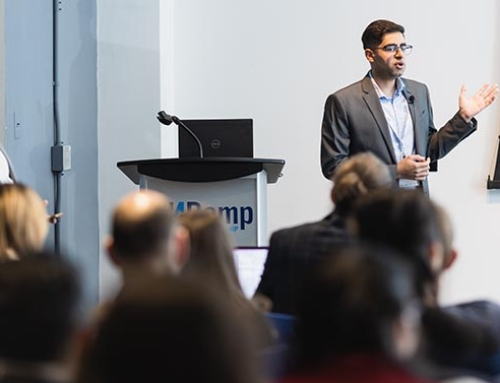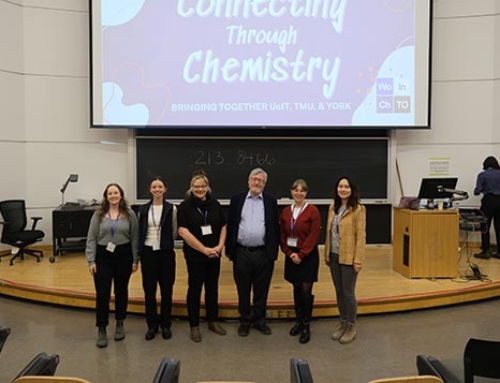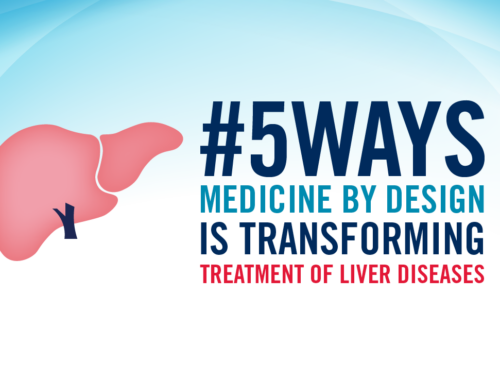
Toronto’s MaRS Discovery District, which neighbours the University of Toronto and the University Health Network, is a major Canadian hub for biotechnology innovation. (Photo by Makeda Marc-Ali)
What can the unprecedented speed of vaccine development during the COVID-19 pandemic teach us about strengthening our bioinnovation ecosystem?

David R. Walt, Wyss Institute at Harvard University and Mass General Brigham Center for COVID Innovation
“Everyone who was working on [COVID-19] had the potential to be affected by it. It was a global imperative that we all cooperate,” said David R. Walt, a professor at the Wyss Institute for Biologically Inspired Engineering at Harvard University.
And, while the nature and global scale of the problem makes the pandemic a unique situation, Walt said, some of the pandemic’s innovations will have a lasting effect, since as a society we “now have some of the tools in place to help catalyze continued innovation and collaboration.”
Walt, who also co-leads the Mass General Brigham Center for COVID Innovation, made these observations as part of a panel of health innovation experts on Friday at the Medicine by Design symposium called, “Strengthening Our Bioinnovation Ecosystem.” The panel followed Walt’s plenary talk called, “Lesson learned from the COVID-19 pandemic.”
The Medicine by Design symposium was held over two days and also included plenary talks from invited speakers Ruslan Medzhitov, a professor in the Yale School of Medicine at Yale University, on the topic of inflammation systems biology; and Linda G. Griffith, a professor in the Department of Biological and Medical Engineering at the Massachusetts Institute of Technology (MIT) who spoke about organ-on-chip technologies, including their application to endometriosis. The symposium attracted more than 500 registrants and finished with the panel discussion on the second day.
The panel discussion looked at the symposium’s theme, A Systems Approach to Regenerative Medicine in a more “holistic fashion,” said Medicine by Design Executive Director Michael Sefton.
“[We’re] looking at healthcare systems and innovation systems with a focus on health policy and social science lessons learned from COVID-19,” said Sefton, who is also a University Professor in the Department of Chemical Engineering & Applied Chemistry and the Institute of Biomedical Engineering at the University of Toronto (U of T).
The panel discussion was timely for Medicine by Design, as it seeks to ensure the bioinnovation system in Canada is well-prepared to advance the regenerative discoveries coming out of the labs of researchers at U of T and its affiliated hospitals.
“We are looking forward to continuing to excel and to prepare the future of human health – to continue to transform but also translate,” said Sefton, whose lab is located at the Donnelly Centre for Cellular & Bimolecular Research, in his opening remarks. “Our goal is to not just write great papers but to also show that these papers can be translated into impact, maybe not immediately, but certainly over the next five or ten years, if not beyond.”
The impact of COVID-19 on the bioinnovation pipeline was just one of themes panelists touched on in the wide-ranging discussion. The panel was moderated by Shiri Breznitz, who is an associate professor at the Munk School of Global Affairs & Public Policy and the director of the Master of Global Affairs Program at U of T.
A problem pull rather than technology push
Often innovations begin with an engineer or scientist inventing a technology and filing a patent before determining the clinical need for their product. But using “design thinking” to innovate can accelerate the timeline of implementation by years, Walt said in his talk.
“If you start with the clinical need first rather than the technology – a clinical pull rather than a technology push – then you come up with a [design thinking] model.”
In the design thinking model, clinicians identify unmet needs, and then scientists and engineers develop solutions to solve those problems. Design thinking “starts with the problem. It has a human-centred core,” said Walt.
Collaboration and trust are important elements of an ecosystem

Catherine Beaudry, Partnership for the Organization of Innovation and New Technologies (4POINTO)
The strength of an ecosystem can be measured by its level of collaboration and trust, said panelist Catherine Beaudry, who leads the Partnership for the Organization of Innovation and New Technologies (4POINTO) and is a professor at Polytechnique Montreal.
“At the heart of all these models, you have to remember that it’s individuals who are collaborating with other individuals. The glue that maintains the ecosystem is trust.”
Beaudry pointed to the importance of having strong intellectual property policies and making sure innovators are collaborating with regulators early in the therapeutics or technology development process as important elements of building trust. She added that using more thoughtful metrics — key performance indicators or KPIs – is also a key part of measuring the health of an ecosystem.
“Bean counting is not the way to go. We need to measure how organizations collaborate, whether these relationships last over time, and what comes out of them.”
Aligning towards a common goal

Beate Sander, Population Health Economics Research, Toronto Health Economics and Technology Assessment Collaborative (THETA)
Beate Sander, a scientist and the director of Population Health Economics Research, Toronto Health Economics and Technology Assessment Collaborative (THETA), pointed to how the speed of vaccine development during the pandemic showed us how the seemingly impossible could be possible.
“The pandemic has shown that we cannot separate health and the economy,” Sander said.
She added, “[In the pandemic] everyone is rallying around similar goals. So everything aligned in a time of very high pressure, very high uncertainty,” said Sander, who is also an associate professor at the Institute of Health Policy, Management and Evaluation at U of T. “How do we move what we have now to post-pandemic times when all that pressure is gone, and everyone will be inclined to go back to what we’ve done previously?”
Sander is an expert in health technology assessment, a multi-disciplinary process that looks at the value of a technology from a wide range of perspectives—not just technical properties, but also many other factors including economic considerations, social and legal impacts and patient perspectives.
Where, normally, innovations would move through a linear process of approvals, said Sander in her opening remarks, things were very different during the pandemic, when many of the phases moved in tandem with each other instead of sequentially. Introducing health technology assessment earlier into the process of innovation would also help speed up the adoption of new technologies.
At the pre-clinical stage, provinces and territories were already planning vaccine roll-outs, said Sander. Health Canada accepted vaccine data on a rolling basis, and data was shared with relevant parties much earlier than it normally would be.
“I hope that some of those characteristics will be maintained, [for instance] parallel review and not having to wait until each step is finished.”
Beaudry said COVID-19 demonstrated the importance of the government being an active part of the innovation ecosystem.
“We need to de-silo the economy because innovation very often is a combination of knowledge from multiple disciplines and multiple sectors. With COVID the government has been forced to do that really quickly. We need to draw the lessons in terms of cross-sector cross agency collaboration.”
Support for new companies and access to risk capital play a large role

Michael May, CCRM
For smaller companies to thrive in the ecosystem, collaboration is an important element, said Michael May, president & chief executive officer at CCRM.
“It’s about alignment of interests. Bringing groups together and understanding the common goal and focusing on that common goal. And it’s a recognition that multiple partners are required for success,” said May. “It’s amazing how much translation and commercialization get stopped by innovators feeling like they have to do it all on their own.”
Aside from collaborations, May said, financial resources play a large role. May contrasted the Canadian ecosystem with the ecosystem in Boston, which is well known for its biotechnology sector and has more access to capital.
“We get bogged down without the financial resources to bring people together…and we’re trying to fill gaps without those resources. [The CCRM model] was built on the premise that we needed to leverage small successes and infrastructure and investments over time to enable access to capital.”
Walt, who has founded or co-founded several life sciences start-ups including multi-billion dollar biotech ventures Illumina, Inc. and Quanterix Corp., agreed that support for small companies is crucial, “The small companies are at the core of innovation. That’s where invention happens; that’s where all the creativity starts.”
Walt adds that Boston and Canadian hubs like Toronto have many similarities. The biotech ecosystem in Boston started because there was a recognition that there was invention and innovation at the universities.
“[In Canada], there are great hubs where there’s concentrations of universities. That’s where most of these ecosystems start. They start with the intellectual capital, then they attract the venture capital, and then they attract more, and it just becomes a self-fulfilling enterprise.”
About Medicine by Design
Medicine by Design builds on decades of made-in-Canada excellence in regenerative medicine dating back to the discovery of stem cells in the early 1960s by Toronto researchers James Till and Dr. Ernest McCulloch. Regenerative medicine uses stem cells to replace diseased tissues and organs, creating therapies in which cells are the biological product. It can also mean triggering stem cells that are already present in the human body to repair damaged tissues or to modulate immune responses. Increasingly, regenerative medicine researchers are using a stem cell lens to identify critical interactions or defects that prepare the ground for disease, paving the way for new approaches to preventing disease before it starts. Medicine by Design is made possible thanks in part to a $114-million grant from the Canada First Research Excellence Fund.





